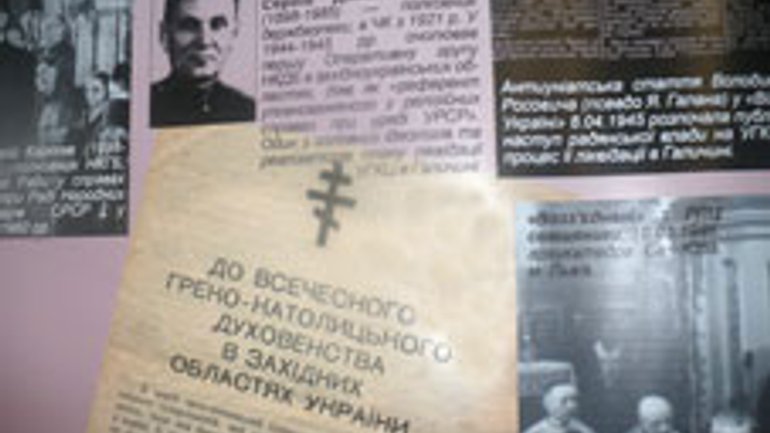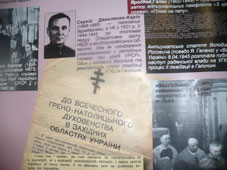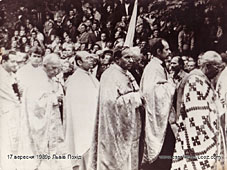65 years ago Ukrainian Greek Catholic Church was banned

 Sixty-five years ago, the Ukrainian Greek Catholic Church (UGCC) was banned. On March 8-9, 1946, at the Lviv synod, also known as the pseudo-synod, it was decided that the Greek Catholics would be transferred to the Russian Orthodox Church.
Sixty-five years ago, the Ukrainian Greek Catholic Church (UGCC) was banned. On March 8-9, 1946, at the Lviv synod, also known as the pseudo-synod, it was decided that the Greek Catholics would be transferred to the Russian Orthodox Church.
Those who refused were repressed. Thousands of priests found themselves in the Soviet Gulag concentration camps, including their leader, Josyf Slipyj, who headed the underground church for 18 years while being in exile. The ban was lifted in 1990.
BBC Ukrainian asked a teacher of the Lviv University and the Orthodox Seminary, Andrii Yurash, why the Lviv synod, which 65 years ago proclaimed the voluntary dissolution of the Greek Catholic Church, is often called a "pseudo-synod."
According to the religious studies expert, as of the time of the council, all the hierarchy of the UGCC were repressed and imprisoned – that is, the church was already left without its leadership, which, according to the church traditions and canons, was the only authority with the right and power to convene councils of its level. The second factor was the interference of the state authorities, the NKVD, the Council on Matters of the Russian Church under the Council of People’s Commissars of USSR, who, undoubtedly, made efforts to legitimize this gathering of the clergy and prove its legitimacy.
“As early as April 1945, practically all of the bishops and several leading superiors of the monasteries were already in the torture chambers of the NKVD. Therefore, they could not possibly receive invitations to the council. Invitations were sent to all the priests, deans, that is, members of the middle and lower level. They could not accept or refuse the invitation. When it became clear that actually none of the bishops or leaders of monastic communities of the UGCC were ready or wiling to cooperate with the Soviet authorities regarding the transfer to Orthodoxy, they were removed from the process itself by force,” Andrii Yurash said.
 In answer to the question of why Stalin needed to liquidate the UGCC, Andrii Yurash responded: “The question of the UGCC should be considered in two dimensions. First, it was the general strategy of the USSR at that time against the Vatican, which was viewed as one of the main enemies and ideological opponents, and, consequently, the UGCC, which was directly subordinated to the Vatican, whose existence could not be tolerated on the territory of the USSR. Second, by then, a strategic cooperation was established between the Soviet atheistic state and the leadership of the Orthodox Church, which after the historic meeting of three metropolitans, who were then leaders of Russian Orthodoxy, with Stalin in 1943 received support at all levels and became part of the ideological machinery of the Soviet Union, and which on its part showed maximal readiness to master the religious space of the Soviet Union after having admitted Catholics who were very close to it according to rite. Of course, no one asked or cared about the real consequences, real priorities of the believers of that community.”
In answer to the question of why Stalin needed to liquidate the UGCC, Andrii Yurash responded: “The question of the UGCC should be considered in two dimensions. First, it was the general strategy of the USSR at that time against the Vatican, which was viewed as one of the main enemies and ideological opponents, and, consequently, the UGCC, which was directly subordinated to the Vatican, whose existence could not be tolerated on the territory of the USSR. Second, by then, a strategic cooperation was established between the Soviet atheistic state and the leadership of the Orthodox Church, which after the historic meeting of three metropolitans, who were then leaders of Russian Orthodoxy, with Stalin in 1943 received support at all levels and became part of the ideological machinery of the Soviet Union, and which on its part showed maximal readiness to master the religious space of the Soviet Union after having admitted Catholics who were very close to it according to rite. Of course, no one asked or cared about the real consequences, real priorities of the believers of that community.”
The expert stressed that it is not an exaggeration to call the UGCC a catacomb church as that church had no possibility to exist in its full form as it did before the war. There existed separate communities. There were only 300-400 centers with comparatively regular life.
Andrii Yurash explained the fact that part of the UGCC clergy did agree to be annexed by the Russian Church because they saw it as a strategy “to survive under any conditions and to bring the spiritual mission to the people while it was impossible to foster that tradition, which was historically established in the region, that is, in the Orthodox form.” It was also seen as a way to preserve at least in any form church structures in the region, which traditionally had been very religious and which carried the spiritual and national content, without which it was absolutely impossible to perceive the Greek Catholic Church.









